This post may contain affiliate links . Read my full Disclosure Policy.
This easy, overnight Sourdough Bagel Recipe is everything you love about a classic bagel, chewy, flavorful, and satisfying, but even better. Made with active sourdough starter, they rise naturally overnight and develop that signature tangy flavor. Keep them simple as plain bagels or customize with your favorite seasonings and toppings for the perfect homemade bagel every time.
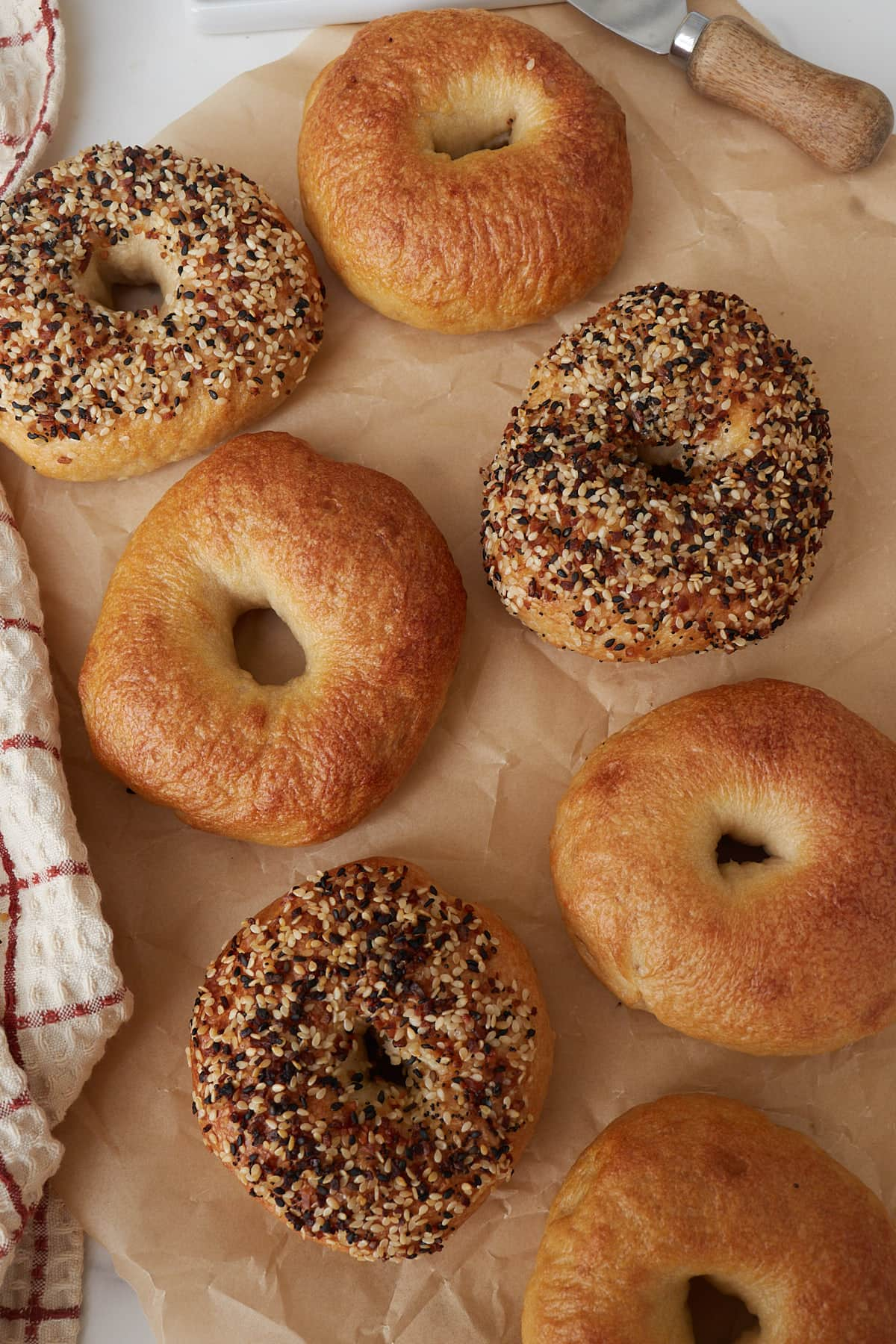
“Wow! I just have to say what a perfect recipe!” – Stephanie
I know it may seem intimidating to make bagels, but I promise they are pretty easy to make and use basic household ingredients you probably have on hand. They pair well with butter or cream cheese, or you can use them to make breakfast sandwiches with your favorite fillings, like an over-easy egg and bacon. If you’re looking for a way to switch things up from baking your usual sourdough bread, this sourdough bagel recipe is just what you need!
Important Ingredients and Substitutions
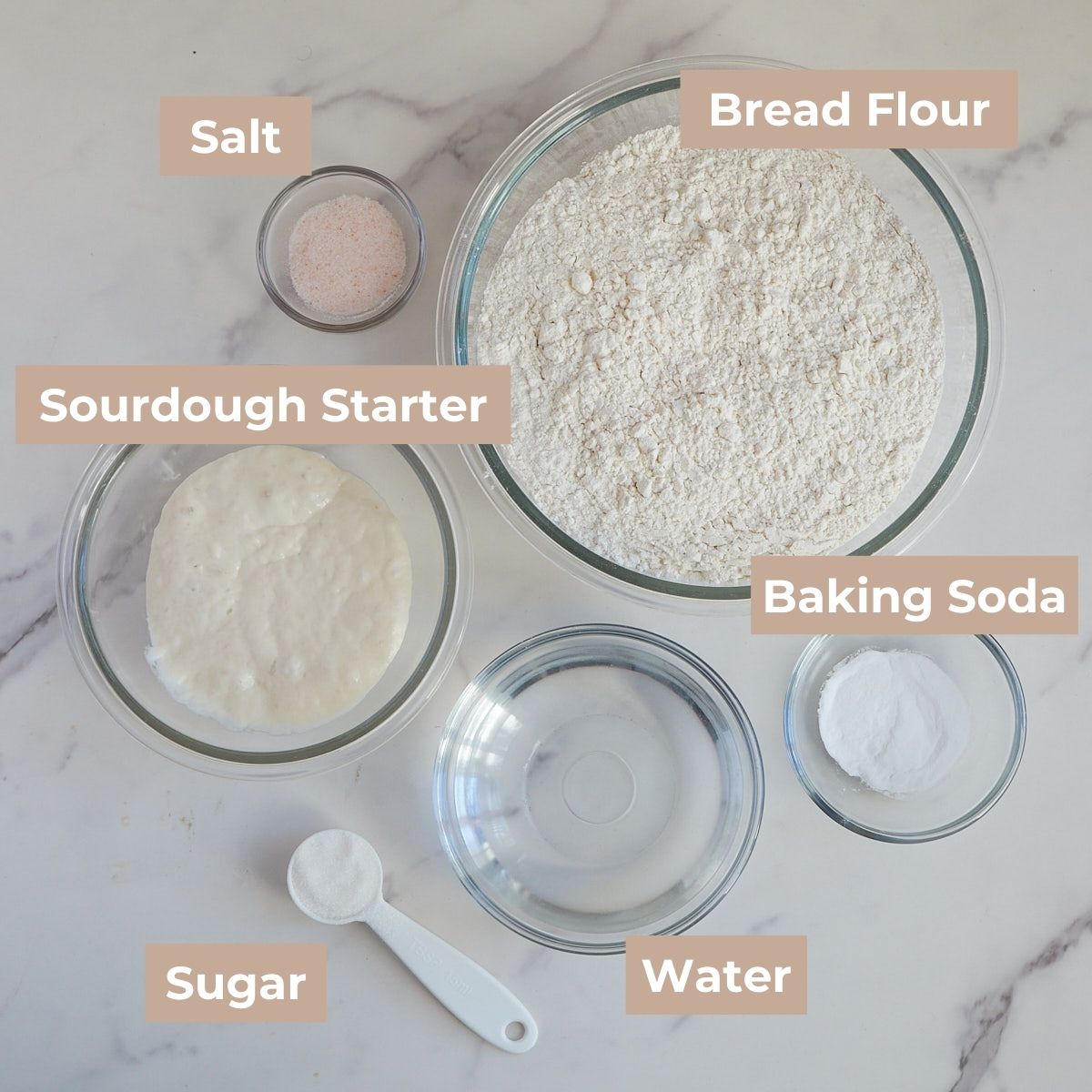
- Bread flour- I like to use bread flour for this recipe to get the best chewy texture. In a pinch, you can use all-purpose flour but I recommend reducing the water by 25 grams.
- Active Starter – This replaces commercial yeast in the recipe and is what leavens the dough. An active starter means that it has been recently fed, bubbly, and doubled in size. Learn more about your starter here.
- Sugar- This helps balance the tang of the starter and adds just a hint of sweetness. You can swap the sugar for the same amount of honey or maple syrup if you prefer.
See all the ingredients and amounts in the recipe card below.
Sourdough bagel flavors
While I love a plain bagel, it is fun to add different flavors and toppings to the bagels. The toppings are added to the bagels after they are boiled, before baking them in the oven. You can make all the bagels the same, or have fun with different flavors! It can be fun to do some savory and some sweet. Here are a few flavor ideas for you to try:
- Shredded Cheese -You can use any type of cheese you like, but I love cheddar, pepper jack, or colby cheese. Sprinkle the shredded cheese on top of the bagel.
- Everything But the Bagel Seasoning– To easily get the seasoning all over the bagel, I like to pour some seasoning on a plate and dip the freshly boiled bagel into the seasoning. If you can’t find this seasoning, you could use a mix of sesame seeds, poppy seeds, dried onion, and dried garlic. Pro tip: make sure the bagel is damp when dipping it in the seasoning or it won’t stick well.
- Jalapeno & cheddar cheese – Sprinkle the cheese and set the jalapeno slices on top of the bagel. I prefer to use pickled jalapenos, but fresh ones work too. (If you love this flavor combination, be sure to checkout my Jalapeno Cheddar Bacon Sourdough Bread and Jalapeno Cheese Sourdough Biscuits recipes.)
- Cinnamon sugar – Using the same technique as the seasoning above, add the cinnamon and sugar to a plate and then dip the top of the boiled bagel into the cinnamon and sugar mixture.
Step-by-step instructions to make Sourdough Bagels
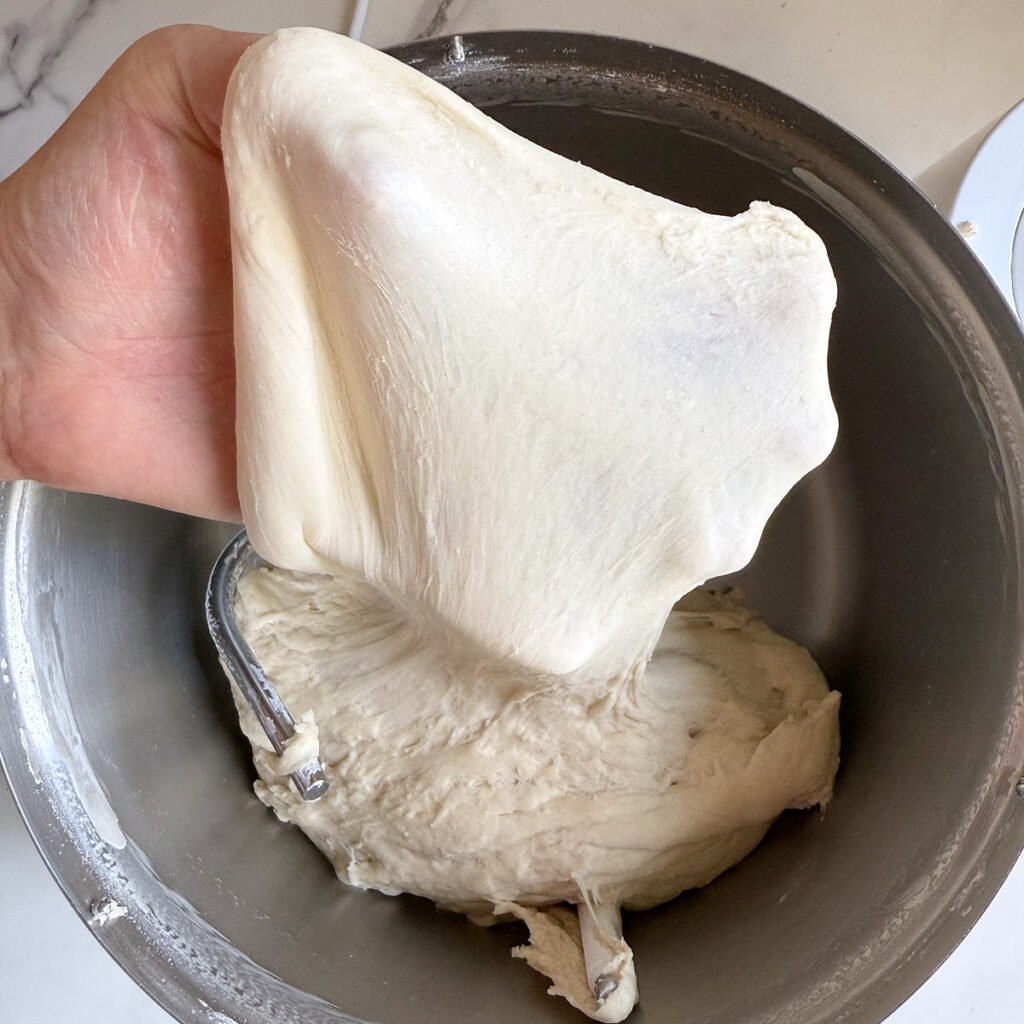
Mix & Knead: Add all the ingredients, except the toppings, to the bowl of a stand mixer. Using your dough hook, knead the dough for about 15-20 minutes or until the dough can pass the windowpane test. The windowpane test is used to see how well the gluten has developed. When the dough is able to stretch thin enough that you can see light through, without it tearing, it has passed. You can also mix this dough in a bowl and then knead it by hand.
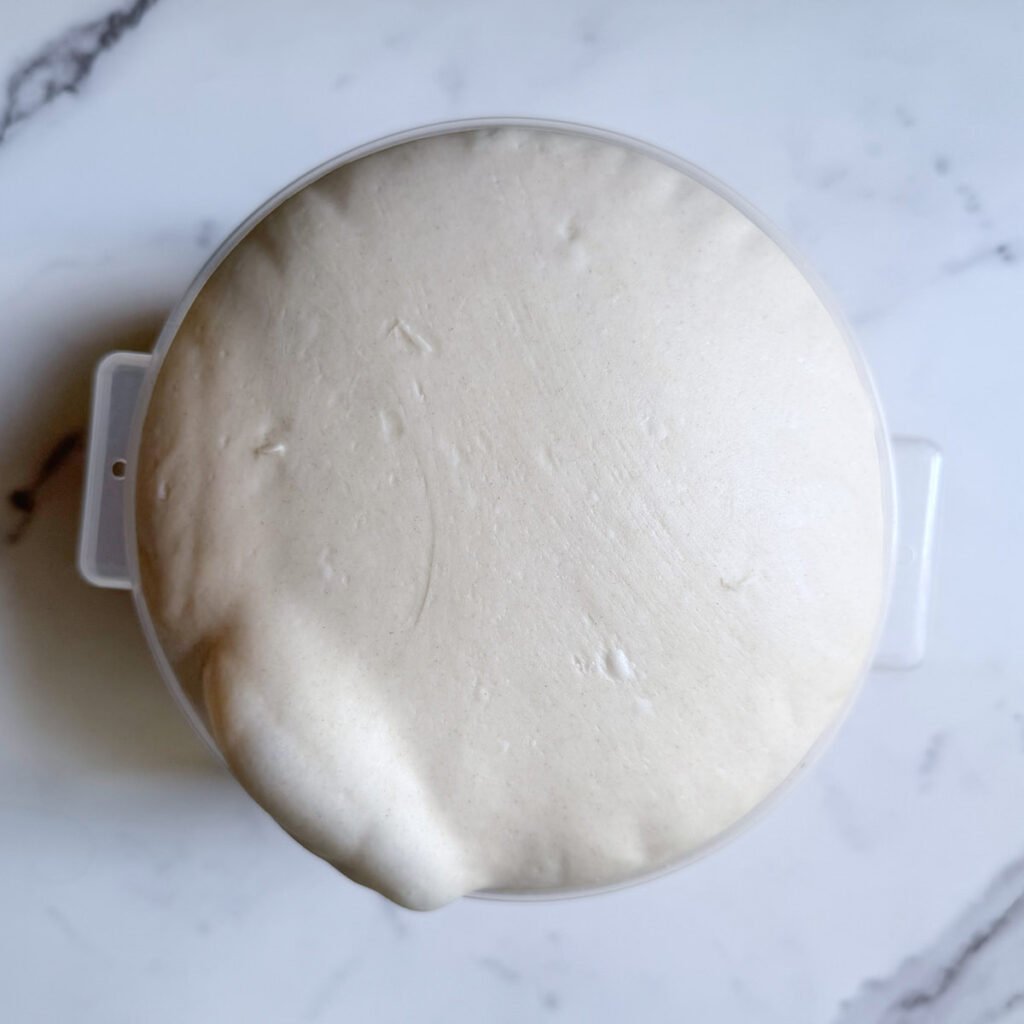
Bulk Fermentation (First Rise): Transfer the bagel dough to a bowl or straight-edge container and let it rise on the counter overnight, covered, until doubled in size. This will take about 8 hours, depending on the temperature of your house. At 72°F, my dough doubled in 8 hours. If your house runs warmer or you need a longer rise time, you can reduce the amount of starter in the dough to 125 grams to slow down the process.
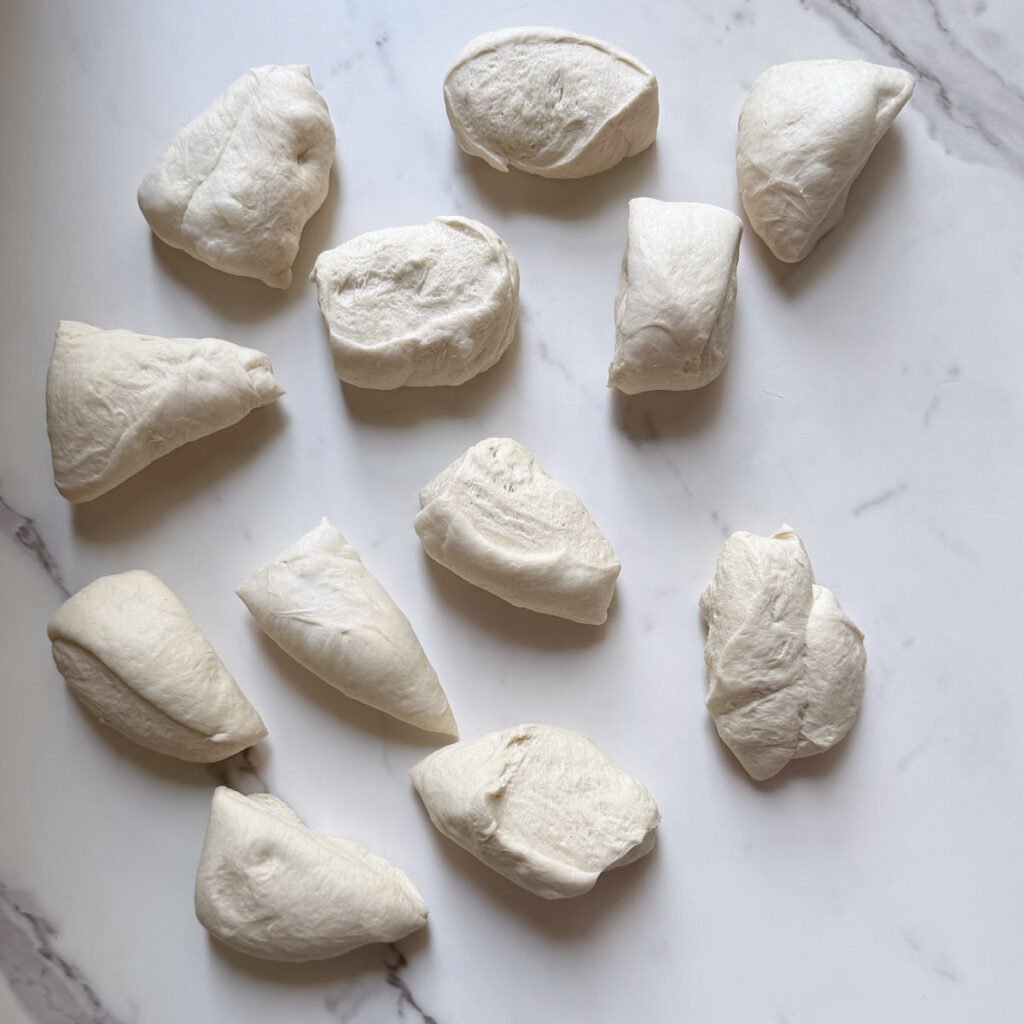
Divide dough: Once doubled in size, punch down the dough and divide it into 12 equal pieces, about 108 grams each. I like to use a bench scraper for this.
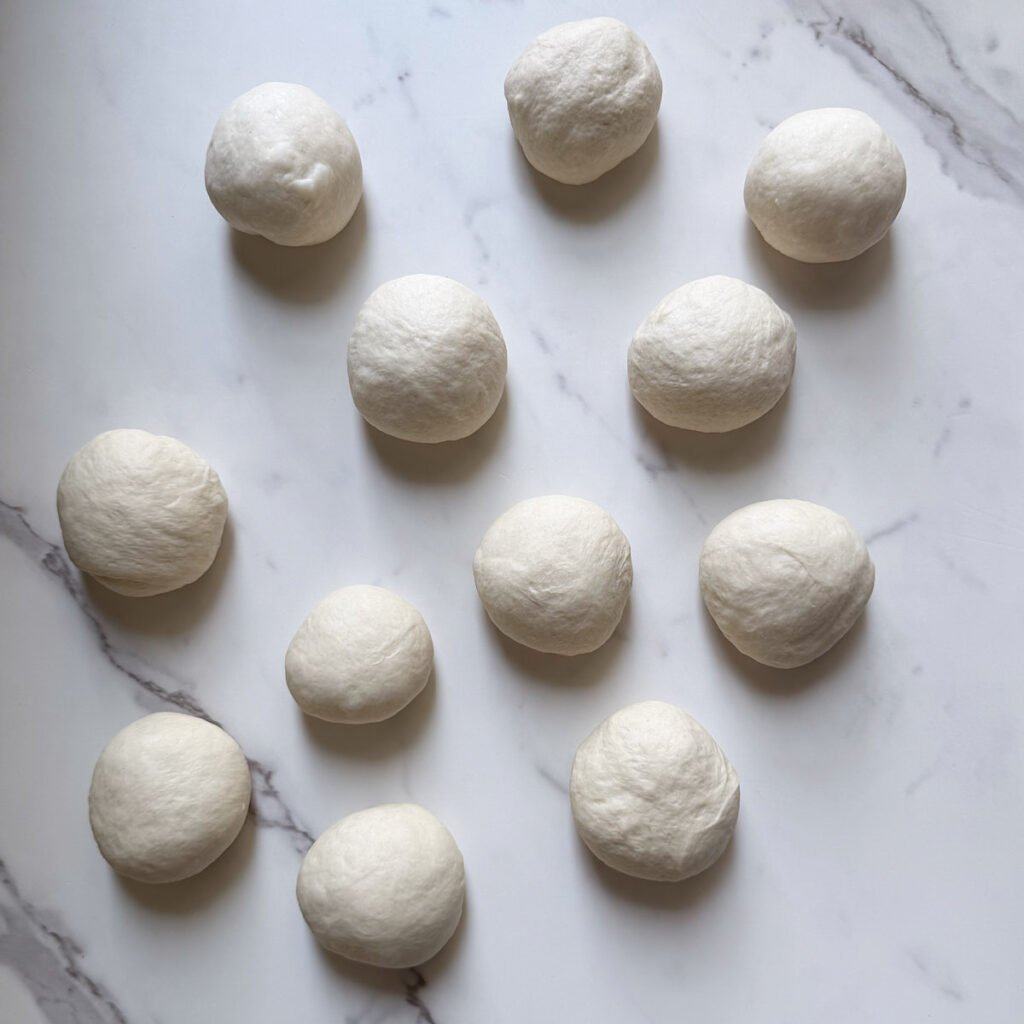
Form into balls: Taking one section at a time, form the dough into a ball by pulling the sides to the middle of the dough and then flipping it over. With your hand in a cupping shape, rotate the dough ball a few times in a circle. Repeat with the remaining 11.
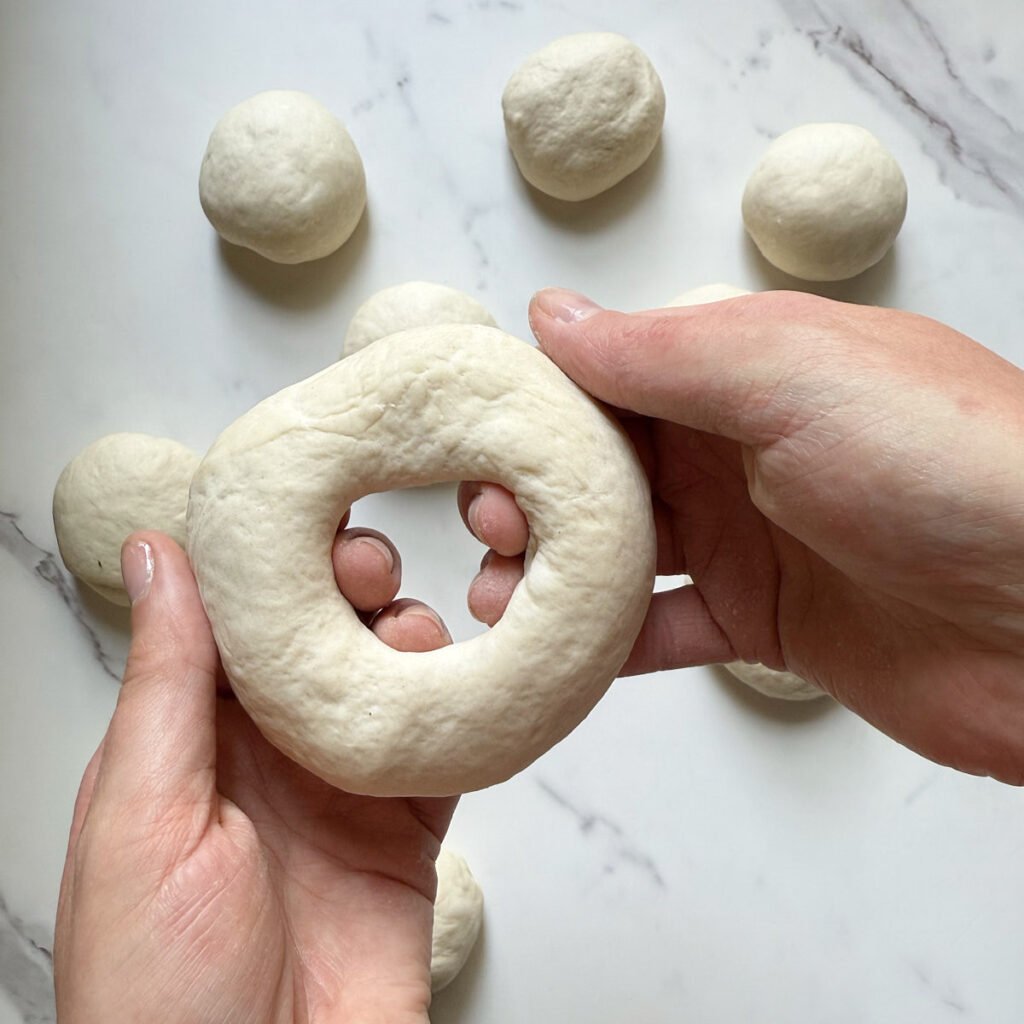
Shape into bagels: Poke a hole in the middle of the dough and then, using both pointer fingers inserted on each side, rotate your fingers around each other, making a hole in the middle of the dough. Ideally you want the size of the hole to be 1.5-2 inches.
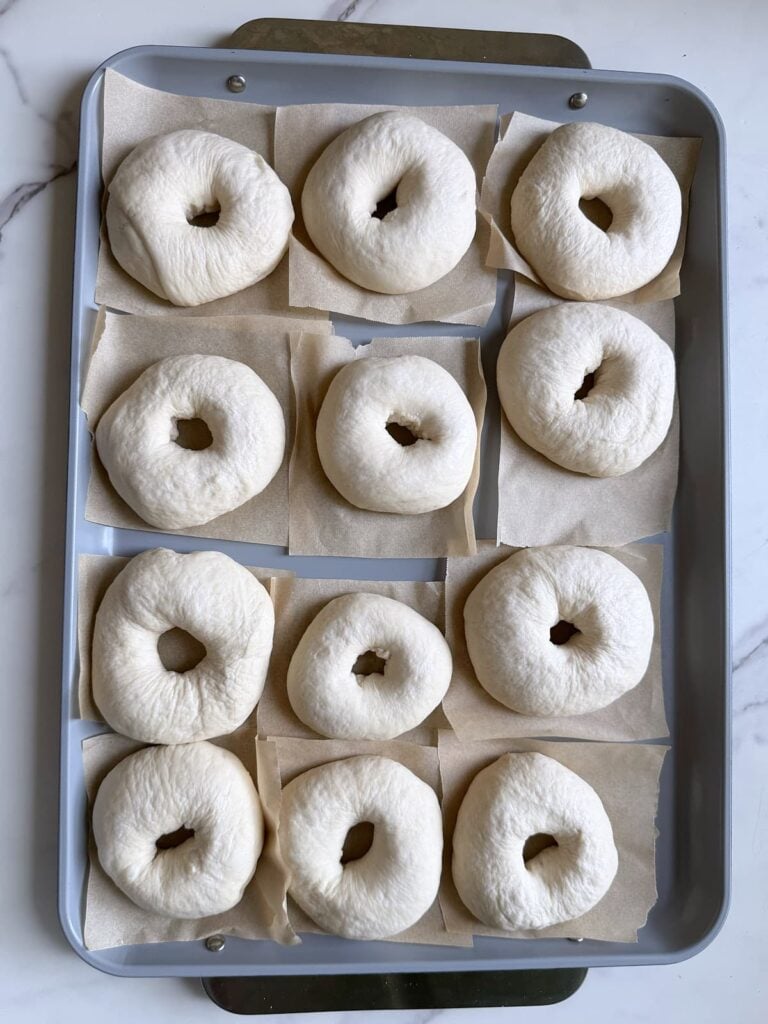
Second rise: Cut twelve 4×4-inch squares of parchment paper. Place a shaped bagel on each piece of parchment paper, and then place all 12 of them on a large baking sheet. Cover with a slightly damp tea towel and let the bagels rise for another 30 minutes to an hour to relax and get puffy. The bagels will not double in size.
Alternatively, you can place all 12 of them on a silicone mat, but when you pick them up to boil them the shape of the bagel can change.
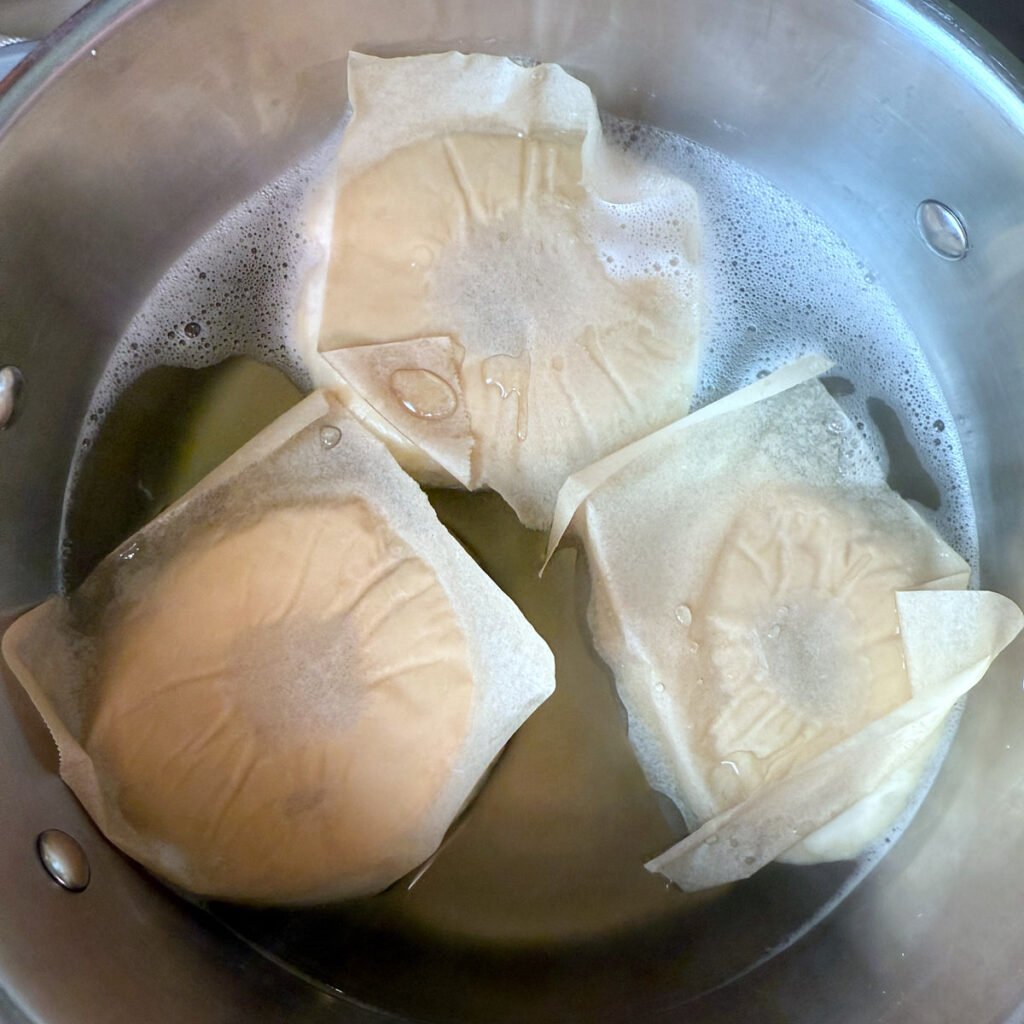
Boil: After the bagels have had a chance to rise, preheat your oven to 425°F. Bring a large pot of water to a boil and add 1 tablespoon of baking soda. Add a few bagels at a time to the boiling water, parchment paper side up, and boil them for about 1 minute on each side. Once the bagels are in the water, you can easily remove the parchment paper from the dough. Use a slotted spoon or spider strainer to easily remove the bagels from the water and drain excess liquid.
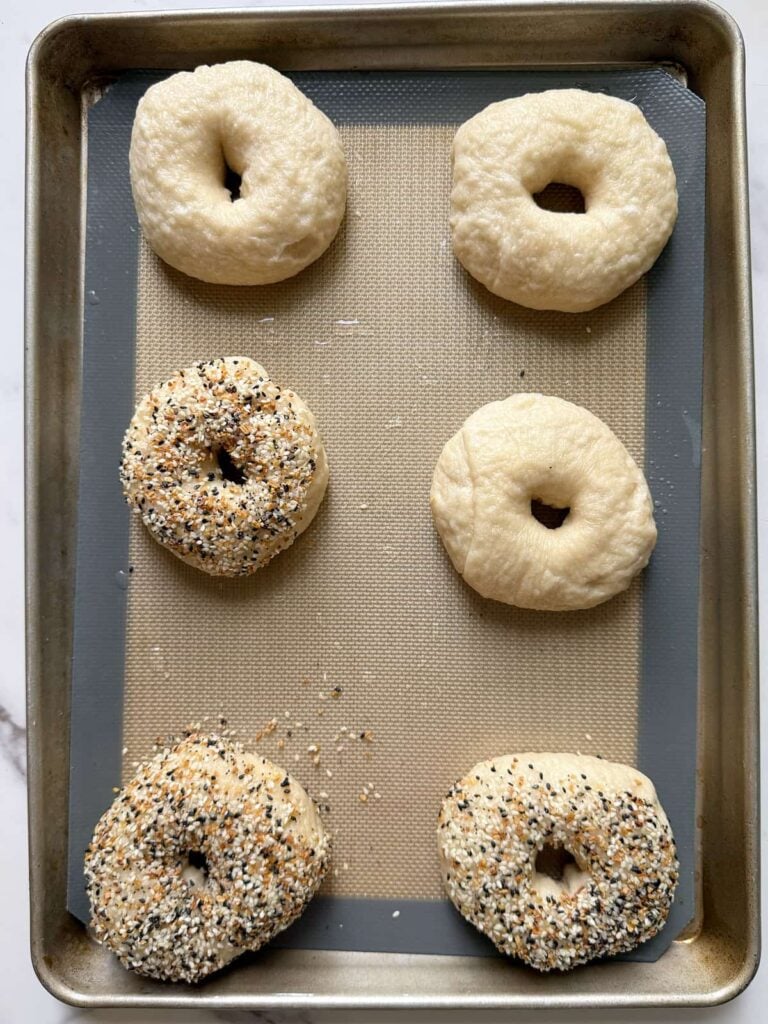
Add toppings: Place the bagels on lined sheet pans, 6 to each pan. Add your toppings of choice to the tops (see notes on flavor options above and for tips on adding to bagels).

Bake: Bake for 18-20 mins or until lightly golden brown. Let the bagels cool on a wire rack and then enjoy them with butter or cream cheese.
Recipe Tips
- I highly recommend making individual parchment paper squares for the bagels to rise on. It makes it easier to put the bagels into the boiling water without messing up the shape.
- If room temperature is 65°F or lower, use a temperature-regulated dough mat (use code country10 for 10% off) or proofing box to keep it warmer. Learn more about tips to keep your dough warm here.
- Knead the dough until it passes the windowpane test. This ensures proper gluten development in the dough.
- Use your sourdough starter at peak. Using a bubbly and active starter will set you up for success and help your dough to rise. Learn more about how to feed and care for your sourdough starter.
- Add toppings, especially seasonings and seeds, when the bagels are damp to help them stick to the bagels.
Sample Schedule
Here is a sample schedule for baking the sourdough bagels. The timeline can depend on the temperature and the activity of your starter, so your time may vary. This schedule assumes the dough temperature is around 72°F.
* Note: if you need a longer rise time than 8 hours, keep the dough in a cooler spot, use cooler water when mixing the dough, or reduce the amount of starter in the recipe by 25 grams.
| Step | Time |
| Feed starter a 1:5:5 ratio and leave at 72°F (15 g starter: 75 g flour: 75 g water) | Day one: 10 am |
| Mix the dough together First rise | Day one: 10 pm |
| Shape the bagels Second rise | Day two: 6 am |
| Boil the bagels and bake. | Day two: 7 am |
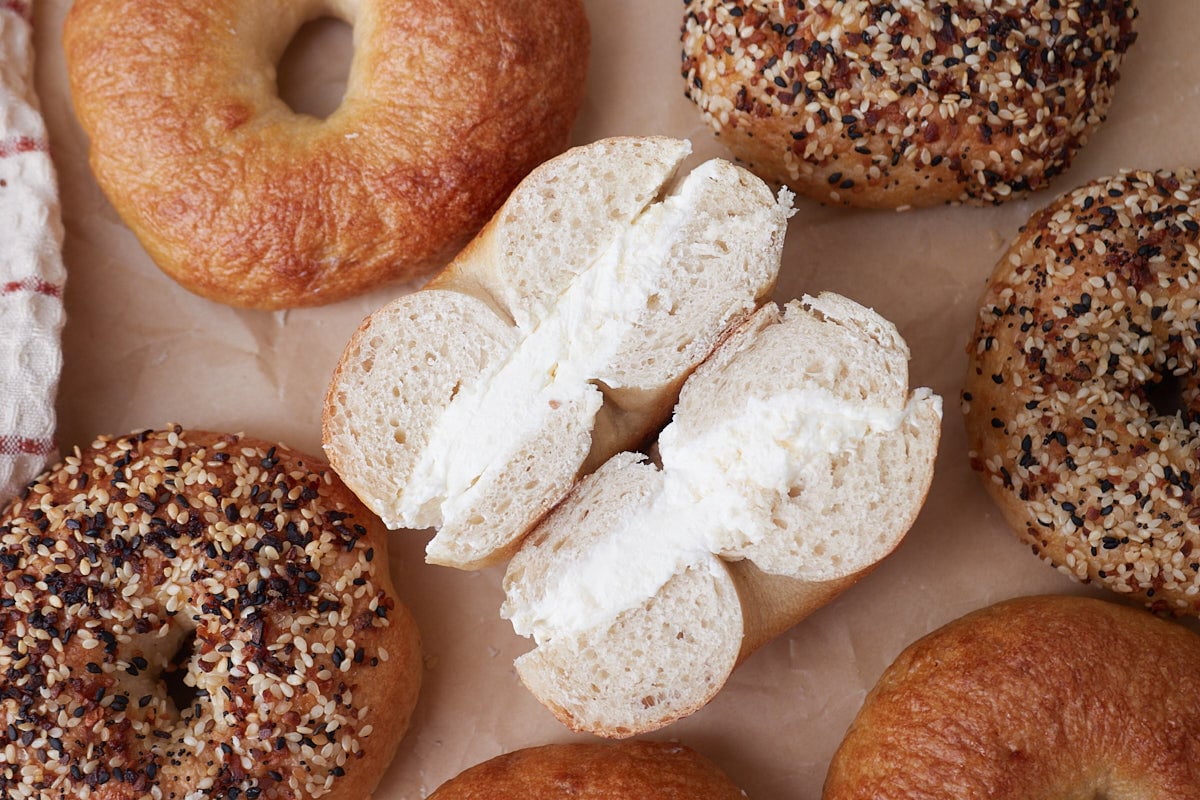
How to store and freeze Sourdough Bagels
You can store these bagels on the counter in a plastic or paper bag for about two to three days. To store the bagels longer, you can freeze them for three to four months. You can either freeze them whole or sliced, and then add them to a freezer gallon bag. To defrost the bagels, pop them in your toaster or oven on a low setting.
Recipe FAQ
Similar to my sourdough pretzel bites, bagels are boiled in water before baking. This gives bagels that chewy texture and shiny crust we all love.
No, baking soda makes the water more alkaline which helps form the shiny, browned crust and chewy texture. You can add honey to the water as well, to create a sweeter flavor, but it’s not necessary in my opinion.
Yes, either honey or sugar will work in this recipe. You will use the same amount regardless. You could also use maple syrup or molasses.
I prefer to use bread flour because it helps yield a chewy texture, but in a pinch, you can use all-purpose flour and reduce the water by 25 grams.
Yes, you can put the dough or the bagels in the fridge before baking. I prefer to refrigerate the shaped bagels so that they are ready to go the next day. Just be sure to allow the bagels to rise and become puffy before baking.
I have a 5qt Kitchen Aide mixer and mine is not strong enough to knead this dough. Unless you have one of the more powerful Kitchen Aide mixers I don’t recommend it as it can burn up the motor. I use my Bosch mixer to knead this dough. Or you can knead by hand.
This can be a sign of overproofing. When the dough is left to rise for too long it can overproof, which deflates the dough, leading to a flatter, wrinkly bagel. By shortening the rise time or reducing the amount of starter in the recipe by 25 grams, it can help prevent overproofing.
Malt is used in some bagel recipes to give the bagels a “malty” smell and flavor and can help with the browning crust. My recipe does not use either of these, as I don’t find it necessary, nor is it a common ingredient everyone has on hand in their kitchen. If you want to add malt syrup to the boiling water, or in place of the honey in the dough, you absolutely can do that.
More sourdough Bread Recipes
Sourdough Artisan Bread Recipes
Same Day Sourdough Bread
Sourdough Bread Recipes
Same Day Sourdough Focaccia Recipe
Sourdough Bread Recipes
Overnight Sourdough Cinnamon Rolls Recipe
Soft Sourdough Bread Recipes
Same Day Sourdough Dinner Rolls
Tried this Sourdough Bagels Recipe or another recipe from the site? I’d love to hear about it! Drop a star rating and share your thoughts in the comments—can’t wait to see what you’re baking!

Sourdough Bagels
Equipment
Ingredients
- 150 grams starter, ½ cup + 2 Tablespoons
- 400 grams water, 1 ¾ cups
- 15 grams sugar or honey, 1 tablespoon
- 15 grams salt, 2 ½ teaspoons
- 750 grams bread flour, 5 ¼ cups
- Optional toppings
- 14 grams baking soda , 1 Tablespoon
Instructions
- Feed your starter: Add flour and water to your sourdough starter and let it sit in a warm spot until it is doubled or more in size and is done growing. It should be bubbly on the sides and top. If you want to feed your starter about 12 hours prior to mixing the dough I recommend a 1:5:5 ratio (15 g starter: 75 g flour: 75 g water) and leaving it at about 72°F. For a quicker rise, you could feed your starter a 1:1:1 ratio (55 g starter: 55 g flour: 55 g water) 4-5 hours ahead of time and leave it at about 77°F.
- Mix & Knead: To the bowl of a stand mixer add active sourdough starter, water, sugar, salt and bread flour. Using your dough hook, knead the dough for about 15-20 minutes or until the dough can pass the windowpane test. You can also mix this dough in a bowl and then knead it by hand.The windowpane test is used to see how well the gluten has developed. When the dough is able to stretch thin enough that you can see light through, without it tearing, it has passed. 750 grams bread flour, 150 grams starter, 400 grams water, 15 grams sugar or honey, 15 grams salt
- Bulk Fermentation (First Rise): Transfer the bagel dough to a bowl or straight-edge container and let it rise on the counter overnight, covered, until doubled in size. At 72°F, my dough doubled within 8 hours. If your house runs warmer or you need a longer rise time, you can reduce the amount of starter in the dough to 125 grams to slow down the process.
- Divide dough: Once doubled in size, punch down the dough and divide it into 12 equal pieces, about 108 grams each. I like to use a bench scraper for this.
- Form into balls: Taking one section at a time, form the dough into a ball by pulling the sides to the middle of the dough and then flipping it over. With your hand in a cupping shape, rotate the dough ball a few times in a circle. Repeat with the remaining 11.
- Shape into bagels: Poke a hole in the middle of the dough and then, using both pointer fingers inserted on each side, rotate your fingers around each other, making a hole in the middle of the dough. Ideally you want the size of the hole to be 1.5-2 inches.
- Second rise: Cut twelve 4×4-inch squares of parchment paper. Place a shaped bagel on each piece of parchment paper, and then place all 12 of them on a large baking sheet. Alternatively, you can place all 12 of them on a silicone mat, but when you pick them up to boil them the shape of the bagel can change. Cover with a slightly damp tea towel and let the bagels rise for another 30 minutes to an hour to relax and get puffy. The bagels will not double in size.
- Boil: After the bagels have had a chance to rise, preheat your oven to 425°F. Bring a large pot of water to a boil and add 1 tablespoon of baking soda. Add a few bagels at a time to the boiling water, parchment paper side up, and boil them for about 1 minute on each side. Once the bagels are in the water, you can easily remove the parchment paper from the dough. Use a slotted spoon or spider strainer to easily remove the bagels from the water and drain excess liquid.
- Add toppings: Place the bagels on lined sheet pans, 6 to each pan. Add your toppings of choice to the tops (see notes on flavor options above and for tips on adding to bagels).
- Bake: Bake for 18-20 mins or until lightly golden brown.
- Cool: Let the bagels cool on a wire rack and then enjoy them with butter or cream cheese.
Video
Notes
Topping ideas:
- Shredded Cheese -You can use any type of cheese you like, but I love cheddar, pepper jack, or colby cheese. Sprinkle the shredded cheese on top of the bagel.
- Everything But the Bagel Seasoning– To easily get the seasoning all over the bagel I like to pour some seasoning on a plate and dip the boiled bagel into the seasoning. This gives the bagel an even coat.
- Jalapeno & cheddar cheese – Sprinkle the cheese and set the jalapeno slices on top of the bagel. I prefer to use pickled jalapenos but fresh works too.
- Cinnamon and sugar – Using the same technique as the seasoning above, add the cinnamon and sugar to a plate and then dip the top of the boiled bagel into the cinnamon and sugar mixture.
Tips for success:
- I highly recommend making individual parchment paper squares for the bagels to rise on. It makes it easier to put the bagels into the boiling water without messing up the shape.
- If the room temperature is 65°F or lower, use a temperature-regulated dough mat (use code country10 for 10% off) or proofing box to keep it warmer. Learn more about tips to keep your dough warm here.
- Knead the dough until it passes the windowpane test. This ensures proper gluten development in the dough.
- Use your sourdough starter at peak. Using a bubbly and active starter will set you up for success and help your dough to rise. Learn more about how to feed and care for your sourdough starter.
- Add toppings, especially seasonings and seeds, when the bagels are damp to help them stick to the bagels.
Nutrition
Nutrition information is automatically calculated, so should only be used as an approximation.


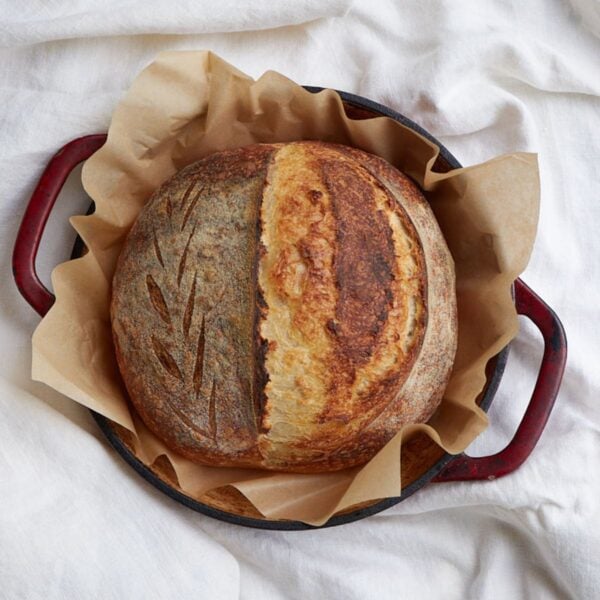





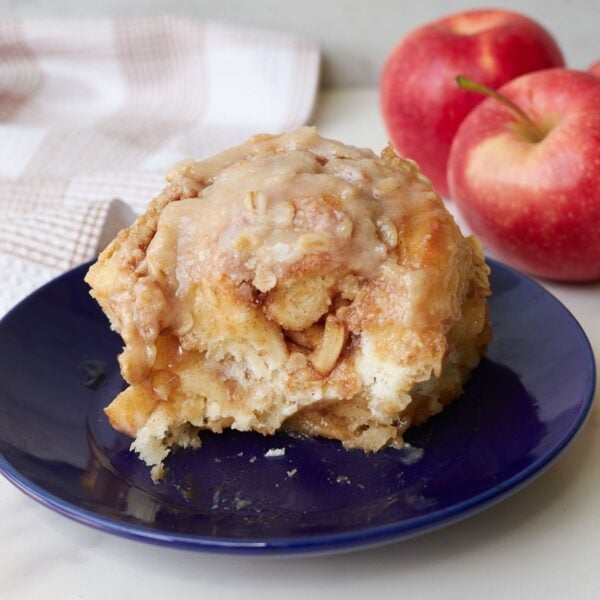
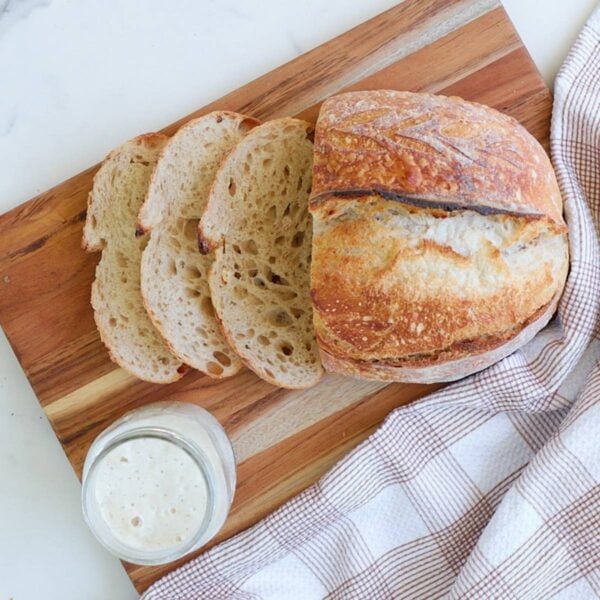
I have loved every recipe that she has created and was so excited when I saw this bagel recipe. It did not disappoint! I started it a bit late and didn’t want to make bagels at 1 am, so I put the dough in the fridge and made them first thing in the morning and they are absolutely delicious!
Dear Emily, I found your website by accident – what a lucky coincidence! I‘m a German pastrychef and love all things baking but always had trouble with sourdough. Three weeks ago I started a new try following your sourdough era course – and it‘s been successful. For the first time I managed to achieve a good starter and last week I made my first artisan bread. This weekend I want to try your bagel recipe – I bet it‘ll be a success too.
Long story short, I wanted to say thank you for sharing your knowledge and giving me and all your other followers the opportunity to discover the endless possibilities of sourdough baking!
All the best,
Sanrina
Can the bagel dough be refrigerated or once the bagels are formed can they then be put in fridge until the following day? I love this recipe but sometimes my timing gets off and I don’t want to be up all night.
Yep you can put the dough or the bagels in the fridge before baking. I prefer to refrigerate the shaped bagels that way they are ready to go the next day.
How would you make these into blueberry bagels? This recipe is fantastic!
I’m working on a blueberry bagel recipe!
If I wanted to do cinnamon raisin would I add some cinnamon and raisins to the initial mix?
Yes!
Thanks! Excited to try that, I love this recipe!
Thank you so much!
Can you freeze the bagels after you cook them?
Yes they freeze great. They will be good for about 3 months in the freezer.
Mi bagels are not getting puffy to be boiled I waited one hour and nothing, can I still move on to the next step.